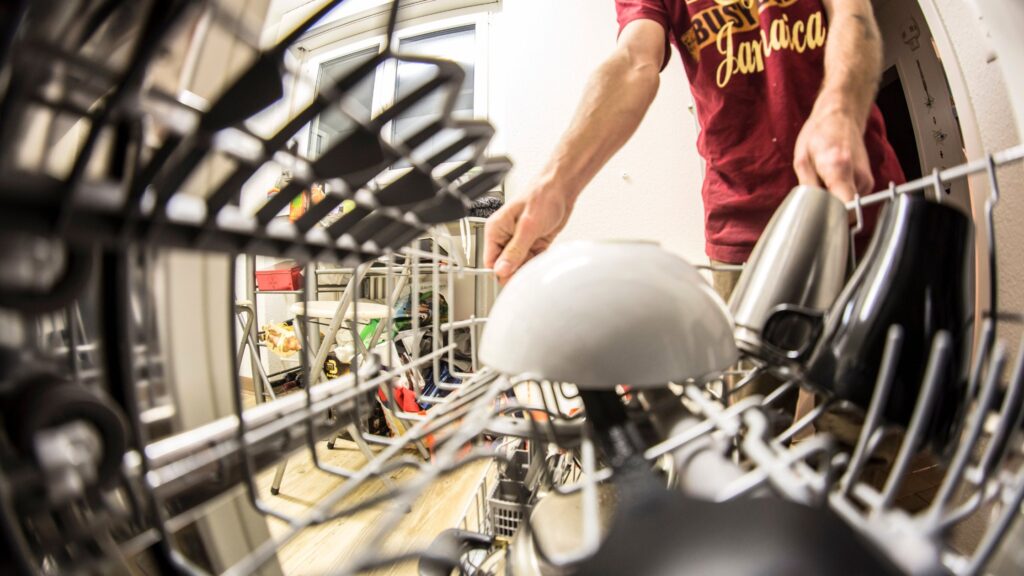Nothing kills the joy of a clean kitchen faster than opening your dishwasher and finding a pool of murky water staring back at you. A dishwasher that won’t drain doesn’t just mean dirty dishes, it can also lead to odors, bacteria buildup, and possible water damage if ignored.
The good news? In most cases, you can troubleshoot and fix the problem yourself with a bit of know-how. Let’s walk through what could be wrong and how to get your dishwasher draining again.
1. How Your Dishwasher’s Drain System Works
Before diving in, it helps to know the key parts that move water out of your machine:
- Filter & sump – trap food debris to protect the pump.
- Drain hose – carries wastewater to your sink drain or garbage disposal.
- Drain pump & check valve – push water out and stop it from flowing back in.
- High-loop or air gap – prevent dirty water from siphoning back into the dishwasher.
- If any of these get blocked, misaligned, or fail mechanically, you’ll end up with standing water.
2. Quick Checks Before Taking Things Apart
Before you grab tools, do these easy checks:
- Run the sink for 30 seconds. If the sink drains slowly, the blockage might be in your household plumbing, not the dishwasher.
- Reset the dishwasher by turning off the power for a few minutes, then starting a drain cycle. Sometimes a glitchy control board just needs a reset.
- Empty the standing water with a cup or sponge so you can see what’s going on inside.
3. Step-by-Step Troubleshooting
A. Clean the Filter & Sump

- Pull out the bottom rack.
- Twist or lift the filter out (check your manual for the exact method).
- Rinse under warm water, scrubbing away grease or food particles.
- Wipe out the sump area to remove any hidden gunk.
Tip: A clogged filter is the #1 reason dishwashers don’t drain, and this step alone fixes most cases.
B. Check the Drain Hose
- Locate the hose under your sink, usually connected to the garbage disposal or sink drain.
- Make sure it’s not kinked, crushed, or twisted.
- Disconnect it (place a towel or pan underneath), then flush it with water or use a flexible brush to clear any buildup.
C. Inspect Garbage Disposal & Air Gap/High Loop
- If your dishwasher drains into a garbage disposal, run it to clear food waste.
- If the disposal was newly installed, ensure the knockout plug inside the drain inlet was removed.
- For setups with an air gap (the small cap near your faucet), remove the cap and clean any debris.
- If you have no air gap, make sure the drain hose has a high loop under the counter to prevent backflow.
D. Test the Drain Pump
- Listen during the drain cycle. If you hear a hum but no water movement, the impeller could be jammed.
- If there’s no sound at all, the pump might not be receiving power or may be burnt out.
- Many pumps are accessible from the bottom panel. Check for obstructions before considering replacement.
E. Check the Check Valve
- The check valve prevents water from flowing back into the tub.
- If it’s stuck open or blocked, you’ll see water re-enter after draining.
- Inspect and clean it. Replacement is simple if it’s damaged.
F. Ensure the Dishwasher is Level
- A tilted machine can trap water in one side of the tub.
- Use a level tool and adjust the legs as needed.
4. Preventing Future Drainage Problems
A little monthly maintenance goes a long way:
- Clean the filter every 3-4 weeks.
- Run a dishwasher cleaner or a cup of white vinegar through a hot cycle monthly.
- Pre-scrape dishes (but no need to fully rinse) to prevent large food chunks from entering the drain.
- Wipe down door seals and spray arms to keep grease and soap scum from building up.
5. When to Call a Pro

Not every drainage problem is a DIY fix. Call an Vancouver appliance technician if:
- You’ve tried all the above and water still won’t drain.
- The drain pump needs replacement.
- Electrical or control board issues are suspected.
- Your dishwasher is still under warranty and repairs may be covered.
Quick Troubleshooting Table
| Problem | Likely Cause | Quick Fix |
|---|---|---|
| Standing water after cycle | Clogged filter | Clean filter & sump |
| Water backs up into tub | Blocked air gap or no high loop | Clean air gap / add high loop |
| Loud humming, no drain | Jammed pump impeller | Remove debris or replace pump |
| Water drains slowly | Kinked or clogged hose | Straighten or clean hose |
| Water returns after draining | Faulty check valve | Clean or replace valve |
A dishwasher that’s not draining can be frustrating, but it’s rarely a mystery. Most issues boil down to clogs, kinks, or minor component failures, which you can often fix yourself. A little regular maintenance can save you from future headaches and keep your kitchen running smoothly.
